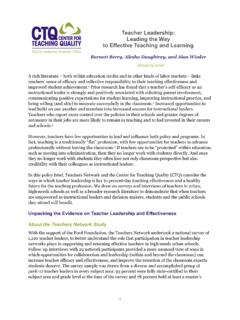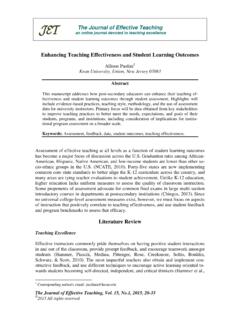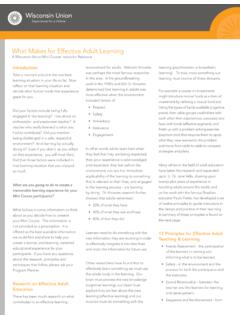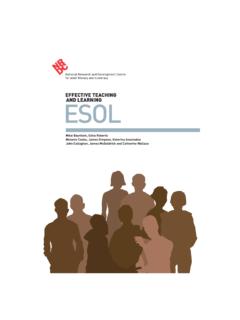Transcription of EFFECTIVE TEACHING METHODS FOR LARGE CLASSES
1 Journal of Family & Consumer Sciences Education, Vol. 24, No. 2, Fall/Winter, 2006 13 EFFECTIVE TEACHING METHODS FOR LARGE CLASSES Jason M. Carpenter University of South Carolina Colleges and universities in the United States are experiencing significant growth in student enrollment ( Department of Education, 2005). Concurrently, enrollment in family and consumer sciences-related programs is growing. As a result, family and consumer science educators face the daunting challenge of TEACHING larger CLASSES while maintaining/improving the quality of instruction and subsequent value delivered to students. This study uses descriptive and inferential statistical techniques to examine the effectiveness of five TEACHING METHODS (lecture, lecture/discussion combination, jigsaw, case study, team project) in a LARGE class setting.
2 In addition, student preferences for class size and TEACHING METHODS are explored. The findings provide valuable direction for faculty TEACHING LARGE CLASSES . According to the Department of Education s 2005 Condition of Education report, undergraduate enrollments in colleges and universities will continue to increase at a steady rate. Class sizes are reaching unprecedented levels. Concurrently, institutions of higher education are pushing faculty to become better teachers and to deliver higher levels of quality and value in the classroom. Delivering quality and value to a LARGE class presents unique challenges. Therefore, it is crucial for faculty to identify viable METHODS of instruction for LARGE CLASSES . Purpose The primary purpose of this exploratory study was to identify EFFECTIVE TEACHING METHODS for the LARGE class environment.
3 The research questions guiding the study were What TEACHING METHODS are EFFECTIVE in the LARGE class environments? and What are students perceptions of these METHODS ? Using student learning outcomes as the criteria for effectiveness, several commonly-used TEACHING METHODS (lecture, lecture/discussion combination, jigsaw, case study, team project) were applied and evaluated in a LARGE class setting. In addition, information on student feelings about LARGE versus small CLASSES and student opinions of the TEACHING METHODS was gathered. It is hoped that the findings from this study will provide actionable directions for faculty charged with TEACHING LARGE CLASSES . Review of the Literature Managing LARGE CLASSES EFFECTIVE management of LARGE CLASSES is a popular topic among faculty in higher education.
4 Carbone (1998) and Stanley & Porter (2002) have produced books focused on the LARGE class environment, offering strategies for course design, student engagement, active learning , and assessment. The advantages of LARGE CLASSES include decreased instructor costs, efficient use of faculty time and talent, availability of resources, and standardization of the learning experience (McLeod, 1998). However, there are significant disadvantages to LARGE CLASSES , including strained impersonal relations between students and the instructor, limited range of TEACHING METHODS , discomfort among instructors TEACHING LARGE CLASSES , and a perception that faculty who teach LARGE CLASSES are of lower status at the institution (McLeod). 14 Class size and student performance Extant research on the relationship between class size and student performance has identified conflicting results (Toth & Montagna, 2002).
5 The results of some studies show no significant relationship between class size and student performance (Hancock, 1996; Kennedy & Siegfried, 1997), while other studies favor small class environments (Gibbs, Lucas, & Simonite, 1996; Borden & Burton, 1999; Arias & Walker, 2004). Results vary based on the criteria used to gauge student performance, as well as the class size measure itself. When traditional achievement tests are used, small CLASSES provide no advantage over LARGE CLASSES (Kennedy & Siegfried, 1997). However, if additional performance criteria are used ( , long-term retention, problem-solving skills), it appears that small CLASSES hold an advantage (Gibbs et al., 1996; Arias & Walker, 2004). Effectiveness of TEACHING METHODS The traditional passive view of learning involves situations where material is delivered to students using a lecture-based format.
6 In contrast, a more modern view of learning is constructivism, where students are expected to be active in the learning process by participating in discussion and/or collaborative activities (Fosnot, 1989). Overall, the results of recent studies concerning the effectiveness of TEACHING METHODS favor constructivist, active learning METHODS . The findings of a study by de Caprariis, Barman, & Magee (2001) suggest that lecture leads to the ability to recall facts, but discussion produces higher level comprehension. Further, research on group-oriented discussion METHODS has shown that team learning and student-led discussions not only produce favorable student performance outcomes, but also foster greater participation, self confidence and leadership ability (Perkins & Saris, 2001; Yoder & Hochevar, 2005).
7 Hunt, Haidet, Coverdale, and Richards (2003) examined student performance in team learning METHODS , finding positive learning outcomes as compared to traditional lecture-based METHODS . In contrast to these findings, a study by Barnes & Blevins (2003) suggests that active, discussion-based METHODS are inferior to the traditional lecture-based method. A comparison of lecture combined with discussion versus active, cooperative learning METHODS by Morgan, Whorton, & Gunsalus (2000) demonstrated that the use of the lecture combined with discussion resulted in superior retention of material among students. Students preferences for TEACHING METHODS In terms of students preferences for TEACHING METHODS , a study by Qualters (2001) suggests that students do not favor active learning METHODS because of the in-class time taken by the activities, fear of not covering all of the material in the course, and anxiety about changing from traditional classroom expectations to the active structure.
8 In contrast, research by Casado (2000) examined perceptions across six TEACHING METHODS : lecture/discussion, lab work, in-class exercises, guest speakers, applied projects, and oral presentations. Students most preferred the lecture/discussion method. Lab work, oral presentation, and applied projects were also favorably regarded. Hunt et al (2003) also noted favorable student attitudes towards active learning METHODS . Methodology Application of TEACHING METHODS An introductory level retailing class was selected for the study (N=109). Specific learning objectives were set forth for each of five chapters, and a different TEACHING method (lecture, 15 lecture/discussion combination, jigsaw, case study, team project) was applied for each chapter.
9 For the lecture format, the instructor used PowerPoint slides and delivered in the traditional manner of the lecture style, with no student input/feedback. In the lecture/discussion combination, the instructor used PowerPoint slides to deliver the material, but discussion questions were included on several slides throughout the presentation. The instructor paused and generated student input/discussion several times during the class session using discussion questions. Students discussed and debated issues relevant to the chapter. The jigsaw method involved grouping the students into teams of four, with each member being given responsibility for reading/ learning a portion of the chapter outside of class. Teams were allowed to meet during the next class and deliver their assigned chapter portions to the rest of their team members.
10 Under the case study method, students were assigned a case study to read prior to class time. They were also required to individually prepare written responses to several discussion questions related to the case study. Once in class, students were then organized into groups of four and instructed to share their individual responses to the questions in order to develop a set of team responses to showcase the best of all of their individual responses. The team project assignment required teams of four students to develop a profile of a retail firm, with the entire project being completed outside of class. Assessment of TEACHING METHODS Students were pretested and posttested using objective, multiple-choice questions covering basic terminology and concepts from each chapter in order to assess knowledge of the material before and after each treatment ( TEACHING method) was applied.






